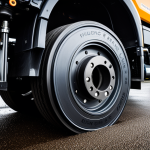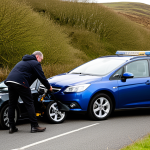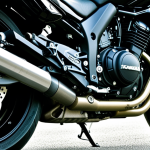Essential Tire Pressure Principles for Sports Cars on Wet UK Roads
Understanding tire pressure basics is crucial for maintaining control and safety in the often damp and unpredictable UK weather. Properly inflated sports car tires ensure optimal road contact, which significantly improves traction on wet surfaces. Under-inflated tires can cause excessive sidewall flex, reducing grip and increasing the risk of hydroplaning on slippery roads. Conversely, over-inflation can decrease the tire’s contact patch, leading to reduced braking performance and uneven wear.
Wet road safety hinges on the tire’s ability to channel water away from the contact patch. Adequate pressure helps maintain tread surface shape, enhancing water displacement and grip. UK weather, characterized by frequent rain and varying temperatures, demands vigilant tire maintenance. Regularly checking tire pressures ensures sports cars perform reliably during sudden showers or persistent wet conditions.
This might interest you : Comprehensive Handbook for Securely Installing a Bull Bar on Your Off-Road Vehicle: Must-Know Tips and Best Practices
For sports car owners, committing to consistent pressure monitoring protects against unexpected handling issues. Tire pressure fluctuations due to temperature changes in UK climates mean pressures should be checked more often than in dry conditions. This proactive approach reduces failures and improves overall vehicle safety when navigating wet roads.
Essential Tire Pressure Principles for Sports Cars on Wet UK Roads
Understanding tire pressure basics is critical for maintaining safety and performance, especially on the often wet UK roads. Proper tire pressure directly affects the contact patch between the tire and road surface, influencing grip, braking, and steering responsiveness. For sports car tires, which are typically designed for high performance, maintaining the correct pressure is even more vital to maximize traction without compromising comfort or tire wear.
This might interest you : Essential Safety Guidelines for Installing High-Speed Rear Spoilers on Performance Vehicles
Wet road safety in the UK presents unique challenges due to frequent rain, cooler temperatures, and varying road surfaces. Under-inflated tires can cause excessive tread flex, reducing grip and increasing the risk of aquaplaning. Conversely, over-inflation decreases the tire’s footprint, limiting water expulsion and also risking traction loss. The fluctuating UK weather demands vigilance in tire pressure maintenance, with checks recommended at least once a week, or before any spirited driving session.
Regular tire maintenance also involves inspecting tread depth and tire condition to complement pressure management. Sports car owners who prioritize these practices experience enhanced performance and greater confidence when navigating wet and unpredictable UK roads.
Recommended Tire Pressure Ranges for Popular Sports Cars in Wet Conditions
Adjusting recommended tire pressures is essential for sports car drivers navigating the often wet UK roads. Manufacturers typically provide baseline pressure ranges tailored for dry conditions, but these can require modification to suit the UK’s frequent rain and cooler temperatures. Lowering tire pressure slightly within the safe range can increase the tire’s contact patch, enhancing grip and wet road safety without compromising stability.
For example, popular UK sports cars like the Mazda MX-5, Porsche 911, and BMW M3 generally suggest pressures between 30-35 psi. In wet weather, reducing these by 2-3 psi can better maintain tire flexibility and tread engagement with the wet surface. This adjustment improves water evacuation and reduces the risk of hydroplaning.
Factors influencing optimal pressure ranges include ambient temperature—colder weather often lowers tire pressure naturally—and tread condition, as worn tires may need higher pressure to avoid excessive flex. Road type also matters; smoother urban surfaces may allow for slightly lower pressures than rough rural roads.
Regularly referencing and adjusting according to manufacturer guidelines, combined with an understanding of local weather impacts and road conditions, ensures tires perform optimally and safely in wet UK environments.
Recommended Tire Pressure Ranges for Popular Sports Cars in Wet Conditions
Finding the recommended tire pressures for UK sports cars involves consulting manufacturer guidelines, which typically specify ideal ranges for dry and wet conditions. These guidelines often suggest slightly higher pressures than usual for wet roads, improving the tire’s ability to displace water and enhancing wet road safety. For example, many sports car models recommend inflating tires to around 2.3 to 2.5 bar in wet conditions, up from a typical dry pressure of about 2.1 bar.
Adjusting tire pressure in response to UK weather is crucial due to fluctuating temperatures and frequent rain. Lower temperatures cause pressure to drop, requiring periodic topping up to maintain the correct level. Tire tread depth and road surface type also influence optimal pressure, as worn tread needs slightly higher pressure to perform well on wet roads.
Key factors affecting pressure settings include:
- Ambient temperature changes in the UK
- Tire wear and tread condition
- Road surface texture and wetness level
Maintaining pressures within these tailored ranges ensures sports car tires deliver maximum grip and handling stability during wet driving, reducing risks such as aquaplaning and loss of control.
Essential Tire Pressure Principles for Sports Cars on Wet UK Roads
Proper tire pressure basics are fundamental to wet road safety, especially in the UK’s unpredictable weather. Maintaining correct pressure optimizes the tire’s contact surface, crucial for sports car tires designed for maximum performance and responsiveness. The UK weather often brings rain and temperature swings that cause tire pressures to fluctuate, making frequent checks essential.
Under-inflation leads to excessive tread flex, reducing grip and increasing the risk of aquaplaning, whereas over-inflation decreases the footprint, impairing water displacement and braking efficiency. Both scenarios jeopardize wet road safety. Therefore, understanding how tire pressure interacts with wet surfaces helps drivers maintain control during sudden showers or extended wet drives.
Sports car owners should integrate regular tire maintenance into their routines, including pressure checks and inspecting tread depth. This proactive approach mitigates handling issues associated with UK weather variables. Ideally, pressure should be checked weekly or before any spirited driving, as temperature drops typically lower tire pressure. Combining these practices enhances wet road safety and preserves tire performance under challenging UK conditions.
Essential Tire Pressure Principles for Sports Cars on Wet UK Roads
Maintaining correct tire pressure basics is vital when driving sports cars in the UK’s wet weather. Sports car tires must balance optimum grip and responsiveness despite frequent rain and cooler temperatures. Incorrect pressures disrupt the tire’s contact patch, directly affecting wet road safety by altering traction and braking effectiveness.
The UK’s wet road surfaces pose specific challenges; standing water and varying temperatures cause pressure fluctuations that can exacerbate risks like aquaplaning. Under-inflated tires increase tread sidewall flex, reducing water expulsion and grip, while over-inflated tires shrink the contact area, impairing steering and braking performance. Both scenarios compromise safety in wet conditions.
Regular tire maintenance complements pressure control. Checking inflation before each drive, especially during rainy weather, helps ensure sports car tires maintain consistent pressure to handle UK roads effectively. Monitoring tire condition alongside pressure supports safe wet-weather performance, preventing uneven wear and premature tire failure.
By understanding and applying these tire pressure basics, sports car owners can navigate the UK’s wet weather with increased confidence, improved handling, and enhanced wet road safety.
Essential Tire Pressure Principles for Sports Cars on Wet UK Roads
Tire pressure basics are foundational to wet road safety, especially given the challenging UK weather. Properly maintained tire pressure ensures sports car tires maintain their optimal contact with wet surfaces, significantly reducing the risk of hydroplaning. Under-inflated tires increase tread flex, causing uneven contact and diminished grip, while over-inflated tires reduce the tire’s footprint, impairing water dispersion and stability.
UK roads often present slippery conditions due to constant moisture and temperature fluctuations. These factors can cause tire pressure to vary daily, making frequent checks critical. Regular tire maintenance, including pressure monitoring and tread inspections, helps sports car owners adapt to these changes and maintain consistent safety levels.
Effective tire pressure management also supports the performance characteristics of sports car tires engineered for responsiveness and high-speed control. Ignoring pressure adjustments in wet UK weather can lead to compromised handling and longer braking distances. Embracing a routine of weekly or pre-drive checks not only safeguards against sudden weather shifts but enhances overall wet road confidence for sports car drivers navigating the UK’s unpredictable climates.
Essential Tire Pressure Principles for Sports Cars on Wet UK Roads
Correct tire pressure basics are fundamental for sports car tires to maintain optimal grip and safety on wet UK roads. The UK weather, known for frequent rain and cool temperatures, poses challenges such as variable road wetness and temperature-driven pressure changes. In these conditions, maintaining accurate tire pressure maximizes the tire’s contact patch and tread performance, which directly impacts wet road safety.
Under-inflation causes excessive tread flexing, reducing water channeling ability and increasing aquaplaning risk, while over-inflation shrinks the contact patch, impairing traction and braking efficiency. This delicate balance means consistent monitoring is necessary to adjust pressures according to temperature shifts common in UK climates.
Regular maintenance is key for sports car owners. Combining frequent pressure checks with assessments of tread depth and tire condition helps prevent unexpected handling issues on slippery roads. Incorporating these practices supports safer driving, ensuring sports car tires perform as intended despite unpredictable UK weather.
Essential Tire Pressure Principles for Sports Cars on Wet UK Roads
Proper tire pressure basics are crucial for ensuring wet road safety in the variable UK weather. Incorrect inflation alters the contact patch of sports car tires, affecting their ability to grip slippery surfaces. Under-inflated tires lead to excessive tread flex, which diminishes traction and increases the risk of aquaplaning on wet roads. Conversely, over-inflation shrinks the tire’s footprint, limiting water dispersion and reducing braking efficiency.
The UK’s frequent rain and fluctuating temperatures demand careful tire pressure management. Daily temperature swings can cause pressure drops, making regular checks essential. Sports car owners who maintain consistent tire pressure avoid sudden handling losses and maintain tyre responsiveness under wet conditions.
Moreover, tire pressure basics extend beyond inflation—it includes inspecting tread depth and tire condition. Worn tires lose their ability to channel water effectively, increasing hydroplaning risk regardless of pressure. Therefore, regular visual and pressure inspections complement each other to uphold wet road safety.
Integrating frequent checks into your routine—weekly or before wet drives—helps counteract the UK’s unpredictable climate effects, keeping sports car tires performing optimally when it matters most.
Essential Tire Pressure Principles for Sports Cars on Wet UK Roads
Managing tire pressure basics is crucial for optimizing wet road safety, especially given the damp and variable UK weather. Correct inflation maintains the sports car tires’ contact patch, which directly affects traction, braking, and steering responsiveness on slick surfaces. Lower tire pressures can improve grip by expanding the contact area but risk excessive tread flex, potentially leading to aquaplaning. In contrast, higher pressures reduce tread deformation but shrink the footprint, diminishing water displacement and wet grip.
The UK’s frequent rain and temperature fluctuations rapidly alter tire pressures. Cooler weather typically lowers pressure by about 1-2 psi, requiring vigilant adjustments to sustain optimal levels. Additionally, standing water and wet road textures challenge tire performance, making consistent pressure monitoring essential for avoiding control loss.
Sports car owners should combine routine pressure checks with regular inspection of tire tread depth and condition. Under-inflation and worn tread increase vulnerability to hydroplaning, jeopardizing wet road safety. Thus, integrating these maintenance steps enables drivers to adapt confidently to the UK’s unpredictable climate and maintain peak sports car tire performance.




